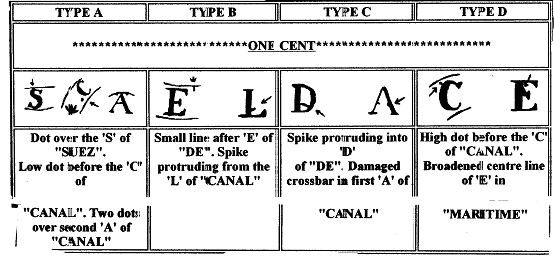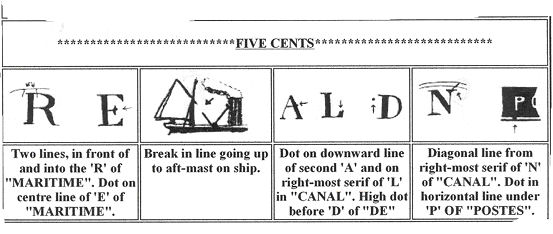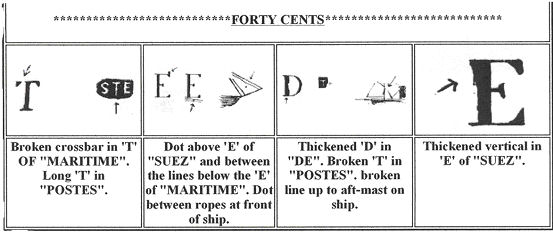
The Stamps of the Suez Canal Company 1868 - Diagnostic Features
A single die for the 20c value was engraved on copper and 120 individual transfers taken and assembled in rows of 12 on the stone used in the lithographic printing process. There are thus 120 impressions of the basic design that show slight variations from each other on account of the constant flaws introduced by virtue of the individual nature of the transfer process.
It is thus possible to ascertain the specific position of an individual stamp on the sheet by matching the constant flaws present on the specimen under examination with those on a stamp from a known position. Although tedious and time consuming, this procedure can provide valuable corroboration of an opinion in regard to the status of a particular specimen reached by a consideration of other factors.
The constant flaws specific to each position on the printing stone have been established and are published in a work by Boulad, Ringstrom and Tester.
A much more simple procedure was adopted for the production of the 1c value. A block of four of the 20c value was transferred onto an intermediate stone, the 20c figures of value in each corner erased and the new value drawn in. A series of thirty transfers from this stone was used to prepare the printing stone of 120 subjects.
This procedure was repeated using different blocks of four taken from the 20c sheet to prepare the printing stones for the 5c and 40c values. There are thus only four primary varieties of each of these values and consequently the exercise of plating individual specimens is much simplified.
In most cases however it will not be necessary to embark on the exercise of attempting to plate a specimen as it can be categorised as a counterfeit by consideration of the following features of the design common to all genuine specimens.
The above diagnostic features are identified in the reproduction below:

.jpg)
An example which meets all the above criteria with the possible exception of the number of passengers observed may be provisionally classified as genuine, but to exclude the possibility that it is a reprint/forgery or in the case of the 40c denomination, a direct reprint derived from the original 40cent lithographic stone which went missing from the Suez Canal archive in Paris sometime before 1907, it will be necessary to confirm that it displays the constant plate flaws native to the transfer from which it was derived. In the case of the 1c, 5c, and 40c values there will be only four types of each that it will be necessary to consider, but for the 20c value the flaws resulting from the use of 120 individual transfers to build up the printing stone will magnify the task considerably.
The plating characteristics of the 1c, 5c, and 40c stamps needed to establish the Transfer Type of a particular specimen are illustrated in the following tables which are based on information included the Boulad and Barefoot publications, and these are reproduced below. As an alternative to the tedious procedure requiring the consideration of the 120 possible variants of the 20c value, I would suggest that honour can be satisfied if steps are taken to exclude the only reported forgery that would make the establishment of the plating characteristics of the 20c value essential.






It is thus possible to ascertain the specific position of an individual stamp on the sheet by matching the constant flaws present on the specimen under examination with those on a stamp from a known position. Although tedious and time consuming, this procedure can provide valuable corroboration of an opinion in regard to the status of a particular specimen reached by a consideration of other factors.
The constant flaws specific to each position on the printing stone have been established and are published in a work by Boulad, Ringstrom and Tester.
A much more simple procedure was adopted for the production of the 1c value. A block of four of the 20c value was transferred onto an intermediate stone, the 20c figures of value in each corner erased and the new value drawn in. A series of thirty transfers from this stone was used to prepare the printing stone of 120 subjects.
This procedure was repeated using different blocks of four taken from the 20c sheet to prepare the printing stones for the 5c and 40c values. There are thus only four primary varieties of each of these values and consequently the exercise of plating individual specimens is much simplified.
In most cases however it will not be necessary to embark on the exercise of attempting to plate a specimen as it can be categorised as a counterfeit by consideration of the following features of the design common to all genuine specimens.
- The sunbursts on each side of the oval containing the inscription consist of a central dot surrounded by 12 rays, some of which touch the inner or outer frame of the oval. Counting from the top of the sunburst in a clockwise direction, the space between rays 3and 4 is greater than that between any other pair.
- The space between POSTES and the oval above has diagonal lines crossing the vertical shading.
- The Filigree ornamentation in the oval between DE SUEZ and the sunbursts on each side end in a flower-like device that displays 3 petals, the central one of which points directly at the bottom-most ray of the sunburst.
- The smoke plume is attached to the smokestack and does not reach as far as the inner border of the oval.
- The rim of the smokestack is solid colour and any shading on the stack is vertical.
- Level with the petals, described in 3, but in the vertical shading outside the oval on each side of the stamp, is a comma-shaped ornament. These are separate from the decoration surrounding the circles containing the value.
- There are 4 passengers on the deck of the ship, one in the bows, two just behind the guy ropes to the foremast and one just behind the mainmast. There is no passenger between the smokestack and the mizzenmast. On some genuine examples it is sometimes difficult to be sure about the number of passengers other than the one in the bows and undue weight should not be placed on the absence of passengers especially in the positions behind foremast or mainmast.
- The mizzenmast appears to be displaced to the left at the point where it meets the lower edge of the smoke plume.
The above diagnostic features are identified in the reproduction below:

.jpg)
An example which meets all the above criteria with the possible exception of the number of passengers observed may be provisionally classified as genuine, but to exclude the possibility that it is a reprint/forgery or in the case of the 40c denomination, a direct reprint derived from the original 40cent lithographic stone which went missing from the Suez Canal archive in Paris sometime before 1907, it will be necessary to confirm that it displays the constant plate flaws native to the transfer from which it was derived. In the case of the 1c, 5c, and 40c values there will be only four types of each that it will be necessary to consider, but for the 20c value the flaws resulting from the use of 120 individual transfers to build up the printing stone will magnify the task considerably.
The plating characteristics of the 1c, 5c, and 40c stamps needed to establish the Transfer Type of a particular specimen are illustrated in the following tables which are based on information included the Boulad and Barefoot publications, and these are reproduced below. As an alternative to the tedious procedure requiring the consideration of the 120 possible variants of the 20c value, I would suggest that honour can be satisfied if steps are taken to exclude the only reported forgery that would make the establishment of the plating characteristics of the 20c value essential.





